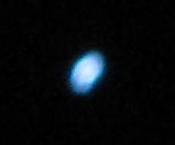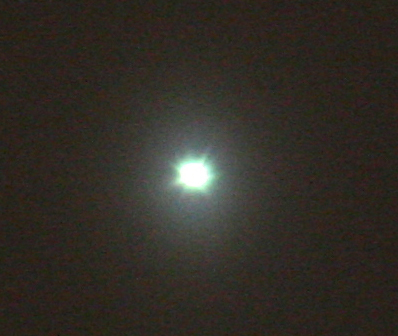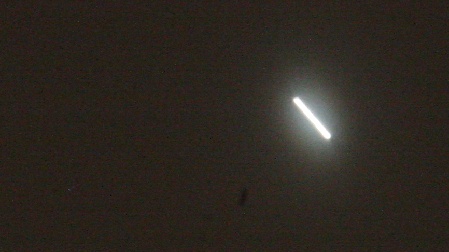
© Till WöhlerMy first photo, taken with a compact digital camera. In spite of the electronic stabilizer, the image is rather blurred.
Till Wöhler is as down-to-earth as you could expect of any German who stands almost 2 meters tall. The China.org.cn journalist is an experienced photographer who is familiar with the night skies. On Monday night he spotted something in the evening sky over Beijing that caught his interest, and for which as yet he has no satisfactory explanation. Here he tells his story in his own words...
"Clear evening skies over the Chinese capital are a relatively rare occurrence, and with the intrusive light pollution for the most part the stars can barely be distinguished. The brightest object in the night sky, the moon, is not visible at the moment.

© Till WöhlerThis next photo (300mm zoom; ISO 800; 0.5 seconds exposure on aperture 5.6) produced a sharp image of a … twinkling object.
At around 6 pm on Monday evening, while returning home from work, I spotted a bright yellow-orange object in the clear skies over Beijing, for which I have as yet no explanation. Some authorities, and many of my own colleagues, are of the opinion that it was the planet Venus, but I'm not so sure. Venus should have been much further south and much lower in the sky at that time in the evening. And not only was the object extremely bright, but it was crossing the skies much quicker than the moon.
A first freehand photo with my compact digital camera was somewhat blurred, in spite of the electronic stabilizer. But consumed with curiosity, as soon as I got home I grabbed hold of my digital reflex camera and returned to the pursuit of the object. What exactly was this thing in the western sky? A star? A planet? A UFO...
Armed with zoom lens and tripod, I was determined to get to the bottom of the puzzle. My first photo (300mm zoom; ISO 800; 0.5 seconds exposure on aperture 5.6) produced a sharp image of a bright object that appeared to be radiating light. It seemed too bright for an aircraft or a satellite, and it was moving very slowly. A longer exposure (30 seconds at ISO 1600 on aperture 40) showed that it was indeed moving steadily in a straight line. It was clearly too slow for an aircraft or a satellite, but too quick for a planet or a star.

© Till WöhlerA longer exposure (ISO 1600; 30 seconds exposure on aperture 40) shows that the twinkling object is moving steadily in a straight line.
Aircraft are equipped with positional lights, and you can easily follow their trajectory. A satellite moves very quickly across the sky; its orbit is relatively low, and it is not particularly bright as it only reflects sunlight. Stars hold their positions much longer, and it can be seen that the stars in my photos have not moved at all, in contrast to the light-radiating object. Further evidence for the speed at which it was moving was provided by the fact that while I was examining my first photos, the position of the object changed to the extent that I had to reposition my camera for the following ones. In the meantime, light cloud cover had begun to obscure the sky - it was only at this point that the object started to bear any resemblance to the planet Venus, which I have observed and photographed so often in recent weeks in the skies over Beijing.
Over the last two days, snowy weather over Beijing has resulted in heavy cloud cover, and nothing has been visible in the night skies. We can only wait and see if the strange object shows itself again. What is it? Venus, or something else? Keep your eyes peeled - maybe you'll be lucky enough to see it yourself..."






Simply excellent, Gentlemen!
Here's hoping the skies clear for the on-going investigation.
I have placed this post on
[Link]
sharing it with Twitter UFO
enthusiasts worldwide.
We track the "good stuff" and this kind of proactive investigation is what we especially appreciate.
Kudos!
IQXS